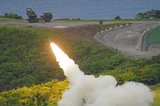USAF suspends KC-46A tanker deliveries again
For the second time this year, the US Air Force has temporarily stopped accepting new KC-46A Pegasus tankers after finding foreign object debris (FOD) in the Boeing-built airplanes.
‘Our inspectors identified additional foreign object debris and areas where Boeing did not meet quality standards,’ USAF spokesperson Capt Hope Cronin said in a statement on 2 April. ‘Air force leadership is meeting with Boeing to approve additional corrective action plans before aircraft acceptance can resume.’
USAF secretary Heather Wilson, who testified on 2 April before the House Appropriations Committee’s defence panel, attributed the FOD problems to a ‘breakdown [in] manufacturing discipline’ that
Already have an account? Log in
Want to keep reading this article?
More from Defence Notes
-
![Taiwan approved for $11 billion weapon purchase from US]()
Taiwan approved for $11 billion weapon purchase from US
The US State Department’s approval of a multi-billion-dollar sale of weapons to Taiwan includes tactical mission networks equipment, uncrewed aerial systems, artillery rocket systems and self-propelled howitzers as well as anti-tank guided missiles.
-
![Ireland spells out $2.3 billion shopping list in five-year defence spending plan]()
Ireland spells out $2.3 billion shopping list in five-year defence spending plan
Ireland’s multi-annual investment in capital defence spending is set to rise from €300m in 2026 to €360m in 2029–2030 with major upgrades across land, air, maritime and cyber domains.
-
![US National Security Strategy prioritises advanced military capabilities and national industry]()
US National Security Strategy prioritises advanced military capabilities and national industry
The 2025 NSS has emphasised investment in the US nuclear and air defence inventory and national industry, but it leaves multiple unanswered questions on how the White House will implement this approach.
-
![Canada set to look away from its neighbour and across the Atlantic for partners]()
Canada set to look away from its neighbour and across the Atlantic for partners
While non-EU UK struggles to join the Security Action for Europe initiative, which provides loans for defence programmes, Canada has become the first country outside Europe to get access – and did so for a nominal fee.
-
![NATO experiments with solutions to integrate networks, AI and uncrewed systems]()
NATO experiments with solutions to integrate networks, AI and uncrewed systems
During the latest edition of the NATO DiBaX, the alliance tested multiple capabilities to inform requirements for future efforts.
























